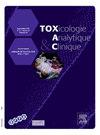Are new compounds spicing up the synthetic cannabinoid receptor agonist market?
IF 1.7
Q4 TOXICOLOGY
引用次数: 0
Abstract
Objective
Investigation of the evolution and pharmacological characteristics of newly emerging synthetic cannabinoid receptor agonists.
Introduction
The synthetic cannabinoid receptor agonist (SCRA) market is constantly evolving and diversifying. Since the emergence of JWH-018 as the first ‘legal high’, designed to circumvent the ban on cannabis, a whole array of compounds have been introduced to the public (followed by equally as many legislative actions) in a true cat-and-mouse game fashion. The enactment of the Chinese generic SCRA ban in 2021 has caused important changes in the recreational drug landscape. Since then, a large set of ‘ban-evading’ substances with a vast structural diversity and never-seen-before features have continuously entered the market. As a consequence, a staggering amount of new, uncharacterized, substances has become available for users who are unaware of the potential health hazards that may be associated with the use of these products. This presentation will elaborate on the recent dynamics in the SCRA market, focusing on the diversity of compounds and the challenges this poses for forensic institutes. An important emphasis will lie on the pharmacological characterization and potential harms of these new substances.
Methods
Pharmacological properties of an extensive set of newly emerging SCRAs were investigated. To accomplish this, their CB1 cannabinoid receptor activation potential was evaluated using in vitro live cell β-arrestin 2 recruitment assays, based on functional complementation of a split nanoluciferase enzyme and the measurement of bioluminescence.
Results
Moving on from the typical JWH-018-like head-core-tail structure, the SCRA market now encompasses a plethora of diverse chemical structures, which are the result of several strategies to evade the Chinese generic SCRA ban. A first strategy included compounds with alternative cores not covered by the legislation. Examples are oxoindolin and oxopyridone cores, yielding OXIZID SCRAs and CH-FUBBMPDORA, respectively, which have a (strongly) reduced potency. An alternative strategy is the insertion of an additional methylene linker (such as for ADB-FUBIATA and CH-PIATA), which also resulted in poor CB1 activity. On the other hand, adding a halogen atom to a typical indazole core yielded substances with a high potency and efficacy, as exemplified by the brominated ADB-5′Br-BUTINACA. This is relevant, as the high potency of this compound may also pose analytical challenges, as relevant concentrations may be very low. Moving the tail moiety to another position in the molecule yielded compounds with almost no activity (e.g., 5F-3,5-AB-PFUPPYCA). Also, removing the tail (as seen in ADB-INACA, MDMB-INACA) resulted in a reduced activity. However, a new phenomenon referred to as “Do-It-Yourself” (DIY) SCRAs appears to be one of the latest ploys to bypass the legislation. So-called “semi-finished SCRAs” are now being advertised online and are often tail-less (ban-evading) compounds (such as MDMB-INACA). These are sometimes even shipped together with the instructions and materials needed to obtain a scheduled SCRA via rather straightforward chemical synthesis at home. This new strategy is potentially very dangerous, as it allows users to obtain (via a detour) potentially very potent compounds (such as MDMB-PINACA synthesized from MDMB-INACA), without the threat of committing a criminal offence for purchasing said compound.
Conclusion
Given the dynamic SCRA market and the concomitant challenges, the continuous pharmacological characterization of newly emerging SCRAs provides valuable and essential information to inform both drug law enforcement agencies and healthcare workers. This information is relevant from a harm reduction perspective, and for prioritization purposes (i.e., to define those compounds that may potentially bear the highest risk). It can be expected that this ever-lasting cat-and-mouse game that describes the SCRA landscape will carry on, with the surge of new and unexpected substances remaining a significant challenge – whether legislative, pharmacologically or analytically.
合成大麻素受体激动剂市场是否出现了新的化合物?
目的研究新型合成大麻素受体激动剂的发展及药理特性。合成大麻素受体激动剂(SCRA)市场正在不断发展和多样化。自从JWH-018作为第一种“合法high”(旨在规避大麻禁令)出现以来,一系列化合物以一种真正的猫捉老鼠游戏的方式被引入公众(紧随其后的是同样多的立法行动)。2021年颁布的中国非专利SCRA禁令导致了娱乐性药物格局的重要变化。此后,一大批具有巨大结构多样性和前所未见特征的“避禁”物质不断进入市场。其结果是,大量新的、未表征的物质可供不了解这些产品的使用可能带来的潜在健康危害的用户使用。本演讲将详细介绍SCRA市场的最新动态,重点介绍化合物的多样性以及这给法医研究所带来的挑战。重点将放在这些新物质的药理学特征和潜在危害上。方法对大量新出现的scra进行药理学研究。为了实现这一目标,基于分裂纳米荧光素酶的功能互补和生物发光的测量,使用体外活细胞β-抑制素2募集试验来评估它们的CB1大麻素受体激活电位。从典型的类似jwh -018的头-核-尾结构开始,SCRA市场现在包含了大量不同的化学结构,这是逃避中国通用SCRA禁令的几种策略的结果。第一种策略包括具有立法未涵盖的替代核心的化合物。例如oxindolin和oxopyridone核心,分别产生OXIZID scas和CH-FUBBMPDORA,其效力(强烈)降低。另一种策略是插入额外的亚甲基连接物(如ADB-FUBIATA和CH-PIATA),这也会导致CB1活性低下。另一方面,在典型的茚唑核上加入一个卤素原子,就会产生高效能的物质,例如溴化的ADB-5'Br-BUTINACA。这是相关的,因为该化合物的高效力也可能带来分析挑战,因为相关浓度可能非常低。将尾部部分移动到分子中的另一个位置产生几乎没有活性的化合物(例如,5f -3,5- ab - pfuppyca)。此外,去除尾部(如在ADB-INACA, MDMB-INACA中所见)导致活性降低。然而,一种被称为“自己动手”(DIY) scra的新现象似乎是绕过立法的最新手段之一。所谓的“半成品scra”现在在网上做广告,通常是无尾(规避禁令)的化合物(如MDMB-INACA)。这些有时甚至与在家里通过相当直接的化学合成获得预定SCRA所需的说明和材料一起运送。这种新策略可能非常危险,因为它允许用户(通过迂回途径)获得可能非常有效的化合物(例如由MDMB-INACA合成的MDMB-PINACA),而不会因购买所述化合物而受到刑事犯罪的威胁。结论考虑到SCRA市场的动态和随之而来的挑战,对新出现的SCRA进行持续的药理学表征为药物执法机构和卫生保健工作者提供了有价值和必要的信息。从减少危害的角度和优先排序的目的(即,确定那些可能承担最高风险的化合物)来看,这些信息是相关的。可以预见的是,这种描述SCRA景观的永恒的猫捉老鼠游戏将继续下去,新的和意想不到的物质的激增仍然是一个重大挑战-无论是立法,药理学还是分析。
本文章由计算机程序翻译,如有差异,请以英文原文为准。
求助全文
约1分钟内获得全文
求助全文

 求助内容:
求助内容: 应助结果提醒方式:
应助结果提醒方式:


